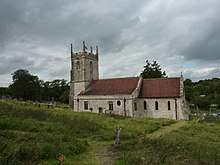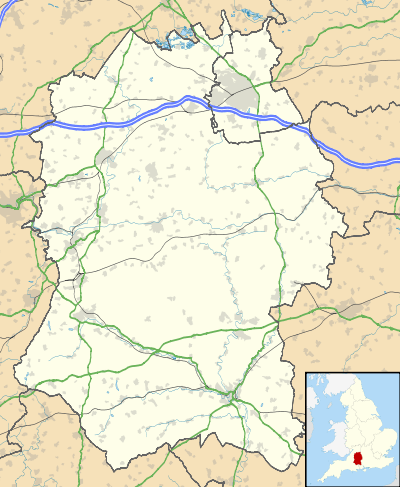St Giles' Church, Imber
St Giles' Church in the deserted village of Imber, Wiltshire, England, was built in the late 13th or early 14th century. It is recorded in the National Heritage List for England as a Grade I listed building,[1] and is now a redundant church in the care of the Churches Conservation Trust.[2] It was declared redundant on 1 November 2002, and was vested in the Trust on 14 September 2005.[3]
| St Giles' Church | |
|---|---|
 | |
| Location | Imber, Wiltshire, England |
| Coordinates | 51.2345°N 2.0513°W |
| Built | late 13th century |
Listed Building – Grade I | |
| Designated | 11 December 1987[1] |
| Reference no. | 313552 |
 Location of St Giles' Church in Wiltshire | |
History
The church was built of dressed limestone in the late 13th century, replacing a church which had stood on the site since the 12th century. The tower with its five pinnacles and the north and south aisles followed in the 14th century.[4] Extensive rebuilding was undertaken in the 19th century. The church no longer has its pews or other fittings; the remains of medieval paintings can still be seen on the walls, including a set of 17th-century bell ringing changes painted on the north wall of the tower.[2]
The village is part of the British Army's training grounds on the Salisbury Plain. The entire civilian population was evicted in 1943 to provide an exercise area for American troops preparing for the invasion of Europe during the Second World War. After the war, villagers were not allowed to return to their homes, so the church's font was moved to Brixton Deverill, the pulpit to Winterbourne Stoke and the seating, bell and two effigies to Edington Priory.[1] The village, which is still classed as an urban entity, remains under the control of the Ministry of Defence despite several attempts by former residents to return. Non-military access is limited to a few days a year.[5] Unlike the rest of the parish, St Giles's church and its graveyard remained in the hands of the Diocese of Salisbury, although access to them was and is controlled by the Ministry of Defence.
The civil parish of Imber was eventually incorporated into neighbouring Heytesbury, to the south, while for Church of England purposes the ecclesiastical parish of Imber was incorporated into the parish of Edington, to the north.
Restoration
By 2001 it had become clear, according to a Church of England press release, that St Giles's "was in need of extensive repairs." Since it was "not possible for the parochial church council to accept liability for the maintenance of a building to which they only had effective access for worship once a year", the Edington-with-Imber PCC requested that Imber church be declared redundant, setting in train a process which ended in 2005 with the vesting of the church in the Churches Conservation Trust. In the meantime, the church tower had been struck by lightning in 2003, weakening the structure, but restoration work commenced in 2008 and the annual service resumed in September 2009 on completion of the works.[6]
After extensive restoration, a ring of six bells was installed in August 2010.[7]
See also
- List of churches preserved by the Churches Conservation Trust in South West England
References
- Historic England. "Church of St Giles, Imber (1036472)". National Heritage List for England. Retrieved 19 November 2013.
- "St Giles' Church, Imber, Wiltshire". Churches Conservation Trust. Retrieved 17 March 2017.
- "Diocese of Salisbury: All Schemes" (PDF). Church Commissioners/Statistics. Church of England. 2011. p. 6. Retrieved 1 April 2011.
- "History of the church". Imber Church. Archived from the original on 22 September 2010. Retrieved 2 October 2010.
- "The lost village of Imber". BBC. 17 September 2010.
- "Deserted village church opens up". BBC. 12 April 2009. Retrieved 2 October 2010.
- Jones, Sarah (8 September 2010). "BBC - 'Ghost village' bells ring after 70 years". BBC News. Retrieved 10 November 2010.